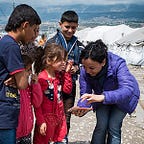Moving Forward Together
A Discussion in view of WFP’s Strategic Plan’s Mid Term Review
The World Food Programme (WFP)’s Strategic Plan 2017–2021 was approved by the WFP Executive Board in November 2016. It was designed with the goal to support countries to end hunger and align WFP’s work with the Agenda 2030, and to contribute to revitalized global partnerships to implement the Sustainable Development Goals (SDGs).
Its mid-term review, which just recently started, offers the opportunity to review the Plan’s essential elements including assessing the extent to which it offered opportunities to develop strategic and operational partnerships supporting Agenda 2030 and contributing to the other SDGs.
Objective
At the Annual Partnership Consultation, the session is a venue to start a discussion with WFP’s main partners on jointly exploring further opportunities to leverage their strategic partnerships, their role among humanitarian actors as well as within the United Nations to positively influence progress towards SDG2 and Agenda 2030.
This session is meant to gather initial contributions from partners to assist the analysis of the direction set by WFP considering the main global trends affecting food and nutrition security, including those discussed during the previous sessions.
Background
WFP’s mandate clearly articulates both its humanitarian and development responsibilities. The Strategic Plan recognizes that relief work must continue to be prioritized to save lives, while doing so in ways that reduce vulnerability, foster development and effectively contribute towards achieving the SDGs, moving beyond saving lives to changing lives.
In line with Agenda 2030, the WFP Strategic Plan does focus on SDG2 but also prioritizes SDG17. Working in synergy with partners, leveraging complementary strengths and relying on partners with stronger comparative advantages is of paramount importance to successfully support countries to achieve zero hunger. Furthermore, to ensure that people in greatest need are reached, leaving no one behind, WFP engages with a wide range of actors in the development and humanitarian sectors.
The Strategic Plan is supported at corporate level by the revised Financial Framework and by the Corporate Results Framework. Five-year Country Strategic Plans guide implementation at the country level.
The Strategic Plan’s Mid Term Review
Commitment to partnership has been traditionally central to WFP’s operations. The Strategic Plan 2017–2021 further reaffirms this commitment. The mid-term review will analyze whether and how WFP Country Strategic Plans are offering a conducive environment to align and integrate food assistance programs with the interventions and the investments of civil society organizations, governments, International Financial Institutions, United Nations agencies and the private sector.
The mid-term review of the Strategic Plan is meant offer the opportunity to:
- gather data and evidence on operationalizing the Strategic Plan and its implementation modalities;
- examine how WFP country offices have shaped their country strategies to tackle the humanitarian-development nexus considering their specific contexts;
- assess the extent to which the Strategic Plan offered opportunities to develop strategic and operational partnerships supporting Agenda 2030 and contributing to the other SDGs;
- inform about any necessary mid-way correction and contribute to the formulation of the next Strategic Plan.
The performance of WFP in operationalizing the Strategic Plan will be reviewed in order to offer high-level considerations and provide recommendations for the final period of the current Strategic Plan.
In particular, the mid-term review aims to help to:
- enable contextualizing the Strategic Plan within the prevailing demographic, socio-economic and geopolitical environment;
- ensure alignment and better coherence with the overarching goals of the UN reform, the strategic directions of the Rome-based agencies as well as other United Nations agencies to create cross-sectoral synergies delivering transformative results;
- facilitate an enhanced partnership with NGOs and Member States including Host Governments;
- consolidate the country strategic planning approach;
- consolidate internal reforms in the areas of financial and corporate results frameworks, organization re-alignment e.g. staff skill-set, etc.;
- gather the perspective of the assisted beneficiaries;
- identify any barriers that may have hindered progress in implementing
Questions for discussion
- Considering the global trends and the factors limiting the successful achievement of SDG2 by 2030, are there opportunities for WFP and its partners to further leverage their role among humanitarian actors and the United Nations to influence progress towards SDG2 and Agenda 2030?
- Does the Strategic Plan provide a conducive environment and appropriate instruments to link humanitarian and development actors through broader and/or new strategic partnerships thus to achieve results reducing saving-life needs?
WFP’s Strategic Plan can be downloaded from this page.
